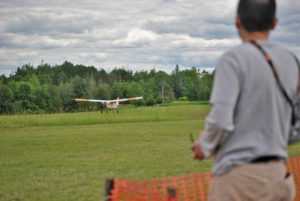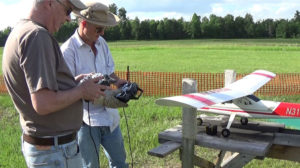The first night of flight training for 2025 will be Wed May 7th.
Contact any of the flight instructors below to confirm instruction on Wednesdays

Student Night
Flying field is reserved for students on Wednesday evenings, between Late April until September. Regular flying is not permitted by other club members. Everyone is welcome to attend and contribute on Student Night with the focus always on creating a fun, cooperative learning environment that will benefit the student pilots.
Weather permitting, instructing starts around 4:00 PM. Please email or text the instructors (scroll to bottom) if you are unsure of the night’s class status.
If you are curious about the hobby and want to know what it’s all about, come out on a Wednesday night. We will be more than happy to tell you all about it and maybe even get you a ride.
No worries if you don’t have an airplane before you join the club. Instructors have training airplanes available for instruction. Once you get to fly these, you will have a much better idea of what you like when you are ready to buy your own.
Flight Instruction Overview
- A fun and positive environment with a few good laughs along the way.
- Students will be accompanied or supervised by an instructor at all times while learning to fly. As you progress in your training, you will also have supervised solo flights. Students should never attempt to fly by themselves.
- Instructors at the ARCC use a buddy-box system which gives both the instructor and the student a transmitter. The buddy-box system, which connects both transmitters with either a cable or wirelessly, allows the instructor to switch who has control between the two transmitters instantly. The buddy-system accelerates training and reduces the number of incidents requiring aircraft repair.
- Instructors have training aircraft for use by new students who have not yet acquired their own trainer. These training airplanes may not always be available. We strongly suggest that students who wish to progress without interruption acquire their own trainer aircraft.
General Recommendations on getting started
- Currently, the most popular radio systems are produced by or compatible with Spektrum. They range in price from $150 to about $2,000 with a “good” radio available for about $400 to $500. If you have a radio system that is not “Spektrum” compatible, we will do our best to accommodate. By “good” radio, we mean a programmable transmitter with a least 8 channels which can also store multiple models. This type of radio will then last you well beyond you first trainer aircraft.
- Many “RTF” (Ready-To-Fly) packages come with a very basic radio and if you stick with the hobby you will very quickly outgrow this radio. Our recommendation is to buy an “ARF” (Almost-Ready-To-Fly) or “BNF” (Bind-And-Fly) airplane and a separate radio system.
- Many students start with a “Foamy” airplane and then move on to larger, heavier, higher performance airplanes. We will typically do the wings test with a larger glow or gas powered trainer. Larger airplanes (60” to 80”) are generally easier to fly than the smaller trainers because they are more stable, easier to see at a distance and can handle higher winds.
Electric vs glow vs gas powered airplanes:
- Battery powered airplanes are the easiest, fastest way to get up and flying. No fussing with engine setups, etc… The downside is that the LiPo batteries used in these airplanes are relatively expensive (depending on quality, capacity, voltage) and may only give you 10 to 15 minutes of flight time. You will need multiple batteries if you want to get more flight time and of course, you will need a fast charger.
- Glow engines have been the engine of choice for smaller, training airplanes for the past several decades. Flight times are only limited by the size of your fuel tank and you can expect these airplanes to be able to fly anywhere from 15 to 30 minutes… On the negative side of the equation, glow fuel is expensive and leaves quite the mess to clean up on your airplane after a flying session.
- Gas powered engines are typically used on larger trainers but for the smaller displacement engines (10 to 20 cc) they are interchangeable with glow engines. They are much more economical to run (regular gas / oil mix) and the cleanup is a lot easier.
Trainer Ready to Fly (RTF) Packages
Includes everything you need to start flying; Airplane, servos, on-board battery, receiver, transmitter, etc.
- If electric, you may want to purchase additional batteries and a fast charger.
- For glow or gas, you will need the appropriate fuel.
- These packages can usually be assembled, ready to fly in just an hour or two.
Trainer bind-and-fly (BNF) Packages
- What’s included – Airframe, accessories, servos, receiver, battery, ESC, electric motor.
- Not included – Transmitter.
- Like the Ready-To-Fly (RTF) packages, these can be ready to go in just an hour or two. You may have to bolt on the flying surfaces then all you have to do is bind your radio to the receiver make sure the setup is correct and you are ready to go.
Trainer Almost Ready to Fly (ARF) Packages
- What’s included – airframe and accessories.
- Not included – radio system (servos, receiver, transmitter), battery, engine or electric motor.
- These packages will typically take about 10 to 20 hours of work to assemble. You will have to install wings, tail surfaces, engine, radio system, fuel system, landing gear, servos.
Trainer Kits / Packages
If you are interested in being more hands on in getting your first airplane flight worthy there are many packages varying from good to excellent quality available. Each will have varying amounts of time required to get to a maiden flight and are available for all budgets. While it is more difficult for the first time RC pilot to assemble a operational trainer by starting from scratch the results can be a superior trainer that could last the student well into the future.
There are many, many online resources such as the following:
Hooked on RC Planes https://www.hooked-on-rc-airplanes.com/rc-trainer-planes.html
Great Hobbies https://www.greathobbies.com/beginners/rcaircraft/index.php
Things to consider
Keep in mind that as a learning pilot your trainer can be expected to take a quite a few bumps along the way to your wings. We suggest new pilots select their trainer not on looks or “I have always wanted it” but for economical rugged practicality in the knowledge that by the time you get your wings most trainers will probably be pretty rough looking from the bumps along the way to success.
 The program’s success hinges on the use of appropriate aircraft for training which are examined and approved for airworthiness by the instructors. Students must only use models that are designed specifically as trainers – high performance or aerobatic models are unsuitable and will not be approved for training purposes.
The program’s success hinges on the use of appropriate aircraft for training which are examined and approved for airworthiness by the instructors. Students must only use models that are designed specifically as trainers – high performance or aerobatic models are unsuitable and will not be approved for training purposes.
All training aircraft must be thoroughly inspected, flight tested, and approved by the instructors. Further, ARCC instructor and/or the Chief Flight Instructor have the final authority in determining which aircraft are to be used in training. We will not approve small “foamie” planes for flight instruction or flight tests as they do not allow the student to acquire or demonstrate the required skills.
Self Taught/Park Flyer Pilots
Members who join the ARCC that were self taught or learned to fly park flyers, will have to pass the wings test when flying their larger airplanes at the field. There is a difference when flying from a MAAC sanctioned club versus a schoolyard or park.
Getting your wings
Getting your wings is very satisfying and will allow you to fly on your own at any MAAC sanctioned airfield. Everyone is different and training could take just a few weeks or could take months. When you and your instructor feel you are ready, you will be required to demonstrate your flights skills and knowledge of the rules.
The wings test consists of the MAAC Guidelines plus knowledge of the ARCC club rules and demonstration of the following maneuvers:
- Take off
- Straight flight
- Flat figure eight
- Low pass
- Rudder turn
- Rectangular approach
- Landing (including crosswind landings)
- Dead stick landing
Daily Checklist
- Fully charged batteries in TX, RX, glow igniter, and field box
- Frequency pin if using a FM transmitter
- Fuel
- Paper towels, rags, cleaning solution (Windex is excellent)
- Rubber bands, tools
- Water or cold drinks
- Bug repellent
- Sunglasses
- Emergency first aid kit
Wings Instructors
Chief Flight Instructor: Dominique Gravel
dom_gravel@sympatico.ca Cell (613) 850-4306
Robert Aube
raube225@gmail.com Cell 613-219-7364
Blades Instructor
Eric Dainty
Eric.Dainty@rogers.com

